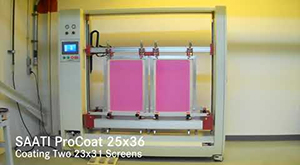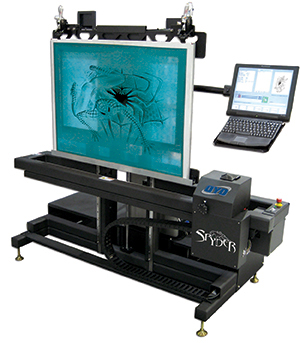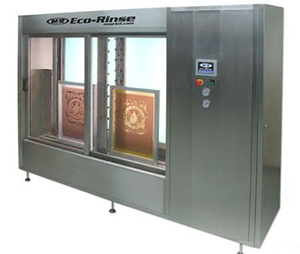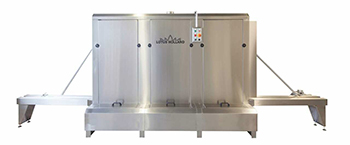Imagine this: Over the course of the last several years you have upgraded and overhauled various assets in your screen print shop. You’ve invested in another automatic press to output more product at a quicker pace. You’ve replaced static frames with retensionable frames to save on mesh consumption. Your electric dryer has been upgraded to a gas dryer to conserve energy costs. You’ve installed high-efficiency air conditioning units throughout your production facility to help keep your staff cool and happy during the summer. Heck, you even spent hard-earned money on quieter air compressors just to cut out that annoying drilling noise that sounds like a gorilla is about ready to smash through your shop wall.
What should you do next? Add another automatic press, or maybe even another manual to continue to pump out more jobs at a quicker pace? You’ve always thought about adding embroidery into your shop ecosystem — maybe it’s time to hit the tradeshow floor and see what that world of decoration has to offer? Not so fast.
While business has likely been flowing pretty well for the last twelve months, you’ve been doing the best you can to automate and upgrade your production workflow. However, in the process you may have forgotten about that messy, smelly part tucked away in a dark corner.
You’re still running a completely manual screen room, and it shows.
Why Automate The Screen Room?
Let’s face it — very few people love spending all day in the screen room. It smells like Swamp Thing’s personal living space, there’s a consistent trickle of water from the washout basin to the floor drain, the lighting is reminiscent of an early ’90s techno rave, and the dress code requires latex gloves and rubber aprons.
Right now, your shop may be turning over a high number of product, but it also may be turning over a high number of employees as well. Amongst many other things, one thing the Great Resignation has revealed is that positions that require an individual to protect themselves from chemical exposure while spending most of their day in a dark, damp room is not an easy position to fill, much less retain.
Listen, I get it. Automating a few things in the messy corner of your shop isn’t as exciting as bringing in a new press, but automating your screen room will allow you to position many of those employees in more desirable areas of your operation, whether that be on-press, in receiving, or providing finishing services for jobs ready to go out the door. While the initial buy-in may be pricy, it will definitely pay itself off over the long haul.
So in what ways can you automate your screen room?
Automatic Screen Coating
Think back to the very first time you picked up a scoop coater. Remember that? It feels like painting the Mona Lisa with your non-dominant hand. You likely wound up with emulsion all over the floor, or at the very least an extremely inconsistently coated screen and Smurf-colored fingers.
 If you’re finding turnover in your screen room high, this process is happening on a regular basis, with new hires learning the finer details of emulsion coating a screen.
If you’re finding turnover in your screen room high, this process is happening on a regular basis, with new hires learning the finer details of emulsion coating a screen.
This is one of the more tedious jobs in a screenprinting shop — but it’s your lucky day, because it can be automated.
Many auto-coaters have been developed to be as simple as plug and play workhorses that provide consistent quality in an easy-to-use, programmable format. On top of that, auto-coaters like the Saati Pro Coat can coat up to two screens at once, front and back.
Through a single program capability, you can simply set the dwell, coats and speed per side then walk away to complete other tasks while the coater does the work for you.
These auto-coaters can double your standard size screen coating output and maximize consistency, while the programming feature will help you achieve repeatable stencils, which results in a more repeatable print.
Computer To Screen/Direct To Screen
If you’re outputting just 25 screens a day, investing in this technology is definitely worth a hard look.
How many times has your film-positive printer decided to randomly stop working as you’re getting ready to initiate setup for a rush order? Not just that, how much money have you simply invested in film positives and printer ink/toner alone over the years?
 A Computer-to-Screen unit, such as the Spyder II CTS, directly images (also referred to as burns) screens in a much more precise, accurate and far more predictable manner than the archaic film-positive method. It does so by directly printing a negative image onto a scoop=coated screen mesh by way of a digital printer utilizing the same RIP software to convert the artwork into the correct file format.
A Computer-to-Screen unit, such as the Spyder II CTS, directly images (also referred to as burns) screens in a much more precise, accurate and far more predictable manner than the archaic film-positive method. It does so by directly printing a negative image onto a scoop=coated screen mesh by way of a digital printer utilizing the same RIP software to convert the artwork into the correct file format.
No more film positives, no more glass covered light box unit and significantly less pinholes from dust or debris to meticulously seek out and tape up when you wash out your screens. Your registration times will likely be cut in half as well, meaning not only will your screen room love your new automated philosophy, so will your press operators. Whereas with the traditional film positive method of manually eyeing where to place the film under the screen prior to exposure, the Computer-to-Screen unit will be able to automatically centrally locate the positioning for imaging the screen with consistency.
Depending on brand and model, you can expect to invest anywhere from $35k to $90k on this worthwhile technology, while reducing time and labor costs in the meantime.
Automatic Rinse
After your screen has been scoop-coated and imaged, one more step remains before your print job is ready to hit the production floor.
In order to remove the imaged stencil on your screen so the ink can pass through, the screen will need to be rinsed with a pressurized water source. In traditional terms, this means standing at a washout basin with a hose in your hand for however long it takes for the desired stencil to fully appear.
This process can now be automated with help from an automatic rinse system.
 Manual rinsing can result in leftover residue, blown out screens, or prematurely aged mesh from over-rinsing with heavy-handed pressure. An automatic rinse, such as the M&R Eco-Rinse, can simultaneously rinse both sides of the screen at optimal pressure.
Manual rinsing can result in leftover residue, blown out screens, or prematurely aged mesh from over-rinsing with heavy-handed pressure. An automatic rinse, such as the M&R Eco-Rinse, can simultaneously rinse both sides of the screen at optimal pressure.
This auto-rinse also has a job recall that can allow operators to store and retrieve multiple rinse sequences for consistency with different mesh and coating types.
Per-screen labor cost can be reduced by up to half, and this unit also reduces water consumption by applying the precise amount of water necessary and then recycling the water used in the wash cycle.
An auto-rinse system saves time, labor and water usage in one single, easy to operate unit.
Automatic Reclaim
The final stop in our fully automated screen room tour may just be your screen room operator’s favorite, as it is often the dirtiest, least desirable position in any screen print operation: the reclaiming process.
With the assumption that you spend enough of your time washing your hands, washing dishes, washing laundry, washing the car, washing your dog, washing your cat (best to not try that one), etc. — the last thing you probably want to do is wash something at work. While the reclaiming of screens is 100% necessary and will include washing, automating this step in your screen room brings a higher efficiency level to this dreaded process, and less consumable waste. The alternative is standing in one place for an entire shift with a power washer in your hands, a scrub brush at your side, and chemicals at the ready.
 An Auto Reclaim system, like the Lotus Holland from Ryonet, can reclaim up to 230 screens per shift. While a rock star reclaimer with a power washer may be capable of reclaiming 15 to 20 screens per hour, that pace is likely not sustainable and is never enjoyable.
An Auto Reclaim system, like the Lotus Holland from Ryonet, can reclaim up to 230 screens per shift. While a rock star reclaimer with a power washer may be capable of reclaiming 15 to 20 screens per hour, that pace is likely not sustainable and is never enjoyable.
Ink is removed from the screen in the initial chamber of this unit via a chemical that is housed in a tank at the bottom and reused repeatedly. Up to 8 gallons of this ink degrader is applied to the screen and reused on the next screen upon completion. With this method, less ink remover chemical is used than would be the case in a manual cleaning process. A vertical line of brushes agitates the ink and degrades it accordingly. A degreaser is also included in this ink degrader, eliminating the need to apply an independent degreaser following the reclaiming process.
The screen then moves into the second chamber where 9 gallons of an emulsion stripper is applied, mixed with recycled water from an independent tank below. The screen is constantly in motion throughout the process as it navigates its way through the unit. Spring doors separate each chamber to prevent cross-contamination as much as possible.
In the third chamber, the screen is exposed to a high-pressure water system on both sides of the screen which moves vertically while the screen moves horizontally. These high-pressure water nozzles hit both sides of the screen at the exact same location, so the mesh is not compromised and subjected to damage from one-sided high pressure throughout the process. This is the only water system in the unit that is constantly being flushed after each use, as it is necessary for fresh water to rinse the screen upon the final step.
As with the other automation techniques listed above, automating your reclaim will boost your screen room operator’s morale, save time, and reduce your consumable costs.
Push A Button And GO!
While it may not be feasible to automate every single aspect of your screen room immediately, now is the time to evaluate which of these four processes is your biggest operational pain point.
Is your pool of unused film positives growing alongside the amount of time it is taking you to register a job on press? Check out Computer-to-Screen!
Is your scoop coater leaving your hands in a permanent claw shape while dripping blue goo all over the shop floor? Automate your coating process!
Tired of employing one person to hold a hose in their hand for 8 hours to rinse out stencils? Automatic Rinse and repeat!
Are you on your fourth screen reclaim operator of the year because you can’t find a person willing to get splattered in wet chemicals for a shift? Claim an Auto Reclaimer!
Investing in just one of these methods will allow you to see just how valuable it is to bring your screen room out of the dark ages, and into the modern daylight.
